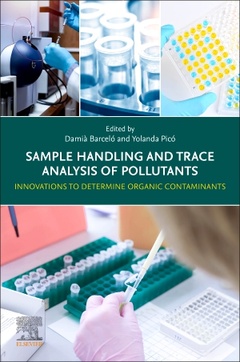Description
Sample Handling and Trace Analysis of Pollutants (2nd Ed.)
Innovations to Determine Organic Contaminants
Coordinators: Barcelo Damia, Pico Yolanda
Language: English
Subjects for Sample Handling and Trace Analysis of Pollutants:
1168 p. · 15x22.8 cm · Paperback
Description
/li>Contents
/li>Biography
/li>Comment
/li>
1. Analytical methods for determining organic compounds in air
2. Passive samplers for the analysis of organic compounds in water samples
3. Extraction of organic contaminants from grab and composite water samples
4. Separation, clean-up and recoveries of trace organic contaminants from soils and sediment
5. Separation, clean-up and recoveries of trace organic pollutants from biota
6. Handling of food samples
Section 2. Trace analysis of organic pollutants
7. Gas chromatography-mass spectrometry
8. Liquid chromatography-mass spectrometry
9. Suspected and non-target high resolution mass spectrometry
10. Imaging techniques. The increasing role of imaging mass spectrometry
11. Immunoassays of organic contaminants
12. Fundamentals and applications of biosensors for environmental analysis
13. The role of nanomaterials and nanoparticles as analytical tools
14. Smartphone as a Portable Detector, Analytical Device, or Instrument Interface
Section 3. Quality Assurance, Reference Materials, Chemometrics and Data Dissemination
15. Certified reference materials for the quality control of measurements in environmental monitoring
16. Standard reference materials for the determination of trace organic constituents in environmental samples
17. Guidelines to establish the quality assurance. Analytical parameters, Inter-laboratory studies
18. Data dissemination and repositories
19. Interpretation of environmental data using chemometrics
20. Determination of the uptake and accumulation of emerging contaminants in soil and plant treated with wastewater
21. Endocrine disrupting compounds
22. Current issues on micro- and nanoplastics
23. Determination of nanomaterials in the environment
24. Detection of antibiotic resistance genes (ARG) in water and sludges
25. Identification of metabolites and/or degradation products of environmental contaminants
26. The anthropic fingerprinting in wastewater: Wastewater based-epidemiology
Yolanda Pico was born in Valencia, Spain, in 1964. She received her Ph.D. in Pharmacy in 1992, after which she was a post-doctoral fellow at the Vrije Universiteit of Amsterdam (The Netherlands) (1992/1993) and at the “La Sapienza University (Rome, Italy) (1996); Assistant Professor of Nutrition and Bromatology at the University of Valencia (1993-1998). Since 1998 she is full Professor of Nutrition and Food Science at the Department of Preventive Medicine and Public Health, Food Science, Toxicology and Legal Medicine of the University of Valencia and the Head of the research group in Food and Environmental Safety (SAMA-UV). Her research interests include identification of unknown compounds by liquid chromatography-mass spectrometry, microextraction separations and environmental and food safety, development of new analytical methods to determine contaminants in food and the environment and the application of methodologies to the risk assessment of different hazard within both field. She is the author of nearly 240 peer-reviewed papers 180 scientific papers in jo
- Includes discussions on techniques such as chromatography coupled to mass spectrometry and emerging areas in nanotechnology, immunoassays and biosensors
- Covers the characteristics, advantages, limitations and potential of each technique, along with current strategies in each method's development and validation
- Outlines practical solutions to challenging problems in the analysis of pollutants in environmental matrices, including how to combine techniques for improved efficacy
These books may interest you

Experimental Mass Spectrometry 210.99 €



